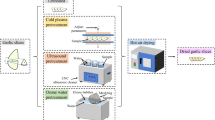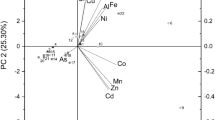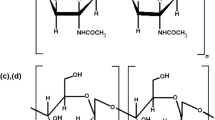Abstract
Lucina pectinata, popularly called Lambreta, is a delicacy very consumed in Bahian cuisine. The shell is composed of nacreous layers formed by keratin, collagen, and elastin, interspersed with layers of calcium carbonate, predominantly calcite, and aragonite phases, which provides protection to the mollusk. As these shells do not readily degrade, provoking environmental imbalance due to their accumulation, this work aims to evaluate the physicochemical and microstructural properties of shells of the species L. pectinata, focusing on the reuse of the solid residue generated by the consumption of this mollusk. The shells were washed, crushed, and subjected to chemical treatment and dried. Subsequently, the physical–chemical and microstructural properties of the samples LN—in nature and LB were treated with sodium hypochlorite. The samples were investigated using Fourier transform infrared spectroscopy (FTIR), X-ray diffraction (XRD), zero load potential (pHpcz), pH determination, moisture content (%), ash content (%), specific surface area, and pore volume by the BET method, scanning electron microscopy (MEV), thermogravimetric/derivate thermogravimetry (TG/DTG), and differential thermal analysis (DTA). The results revealed that calcite and argonite phases are present in the two samples with high calcium carbonate content (95%) and that thermal decomposition occurs in the range of 575 to 810 °C, producing CaO and CO2. Treatment with sodium hypochlorite (sample LB) promoted leaching in the solid by dragging possible lamellae, which culminated in superficial erosion of solids, resulting in a better cavity and pore distribution profile on the surface, besides increasing the specific surface area in relation to sample LN.







Similar content being viewed by others
References
Dias R. Environmental management: social responsibility and sustainability. São Paulo: Atlas; 2011. p. 220.
Nascimento EP. Trajectory of sustainability: from environmental to social, from social to economic. Adv Stud. 2012;26(74):51–64.
Tretto, D. What is sustainability. Revista de Administração de Roraima-RARR, Boa Vista. 2014;4, ISSNe: 2237-8057, 115–7.
Freitas J. Sustainability: right to the future. Belo Horizonte: Forum; 2011. p. 55.
Boff L. Sustentabilidade: O Que É, O Que Não É. Petrópolis, RJ: Ed. Vozes; 2012.
Jacobi PR, Besen GR. Solid waste management in São Paulo: challenges of sustainability. Adv Stud. 2011;25:135–58.
Souza NK. Adsorption of cationic and anionic dyes in aqueous solution using new materials bi-functionalized from sugarcane bagasse. Dissertation (MSc in Environmental Engineering)—Federal University of Ouro, Ouro Preto. 2013.
Tenorio HCL, Motta PMS, Gonçalves LB, Marinho AA. Reutilization of shells of shellfish and construction waste in Alagoas. Exact Technol Sci. 2014;1:61–71.
Shih P-K, Chang W-L. The effect of water purification by oyster shell contact bed. Ecol Eng. 2015;77:382–90.
Christo SW, Ivachuk CS, Ferreira-Junior AL, Absher TM. Reproductive periods of Lucina pectinata (BIVALVE; LUCINIDAE) in the Paranaguá Estuarine Complex, Paraná—Brazil. Braz J Biol. 2016;76:300–6.
Barbosa IS. Distribution of essential and non-essential elements in bivalve molluscs and sediments from Bahia de Todos os Santos, Bahia, Brazil. Dissertation (Master in Chemistry)—Federal University of Bahia, Salvador. 2013.
Silva D, Debacher NA, Castilhos ABJ, Roher F. Physical–chemical and microstructural characterization of shells of bivalve molluscs from the coastal region of Santa Catarina Island. Quim Nova. 2010;3:1053–8.
Barros IS. Physical and chemical characterization of shells of the species Lucina pectinata and its application as adsorptive material. Dissertation (Master in Chemistry)—State University of Bahia, Salvador, 2016.
Nascimento RF, Lima ACA, Vidal CV, Melo DQ, Raulino GSC. Adsorption: Theoretical aspects and environmental applications. Fortaleza: University Press—(Postgraduate Studies); 2014.
Lutz, IA. Physical–chemical methods for food analysis. São Paulo: Institute Adolfo Lutz, 4:2008.
Silva DF. Synthesis and characterization of calcium phosphate biomaterials from fossilized limestone shells. Dissertation (Master in Materials Science and Engineering)—State University of Santa Catarina, Joinville. 2012.
Paiva RM. Synthesis and characterization of pure calcite nanoparticles and doped with manganese. Dissertation (Master in Physics)—State University of Rio Grande of Norte, Mossoró. 2013.
Szczes A, Sternik D. Properties of calcium carbonate precipitated in the presence of DPPC liposomes modified with the phospholipase A2. J Therm Anal Calorim. 2016;123:2357–65.
Hannah, RW, Swinehart, JS. Experiments in techniques of infrared spectroscopy. Perkin Elmer Corporation, Universidade de Minnesota; 2011. pp. 95.
Barbosa CS, Santana SAA, Bezerra CWB, Silva H. Removal of phenolic compounds from aqueous solutions using activated carbon prepared from water hyacinth (Eichhornia crassipes): kinetic study and thermodynamic equilibrium. Quim Nova. 2014;37:447–53.
Sanatana JA, Santos WNL, Silva LOB, Virgens CF. Removal of mercury(II) ions in aqueous solution using the peel biomass of Pachira aquatica Aubl: kinetics and adsorption equilibrium studies. Environ Monit Assess. 2016;188:293.
Santana MFS, Katekawa ME, Tannous K, Lima AKVO, Gasparetto CA. Surface area and porosity of dietary fiber of orange albedo. Braz J Agroind Prod. 2012;14:261–73.
Olszak-Humienik M, Jablonski M. Thermal behavior of natural dolomite. J Therm Anal Calorim. 2015;119:2239–48.
Acknowledgements
We thank the Graduate Program in Applied Chemistry of University of the State of Bahia (UNEB). Dra. Mariângela Vieira for the moisture content and ash analyzes. To Center for Strategic Technologies of the Northeast (CETENE) institution for carrying out the pore volume and specific surface area analyses using the BET method. Mr. José da Cunha, owner of the Restaurant Lambreta.com, for the supply of shells after consumption by customers.
Author information
Authors and Affiliations
Corresponding author
Additional information
Publisher's Note
Springer Nature remains neutral with regard to jurisdictional claims in published maps and institutional affiliations.
Rights and permissions
About this article
Cite this article
Barros, I.S., Oliveira, A.S., dos Santos, A.V. et al. Physical–chemical and microstructural study of shells of the Lucina Pectinata species. J Therm Anal Calorim 138, 869–878 (2019). https://doi.org/10.1007/s10973-019-08272-y
Received:
Accepted:
Published:
Issue Date:
DOI: https://doi.org/10.1007/s10973-019-08272-y




